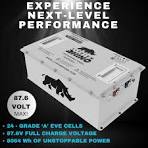Rhino batteries are a popular choice for remote control (RC) hobbyists and enthusiasts who need dependable power sources for their electric vehicles, drones, planes, and other RC models. These batteries are known for offering a balance between performance, reliability, and affordability. In this article, we’ll explore what Rhino batteries are, their types, key features, and why they are favored in the RC community.
What are Rhino Batteries?
Rhino batteries are a line of rechargeable lithium polymer (LiPo) batteries designed primarily for use in remote control vehicles and other high-demand electronic devices. LiPo batteries are known for their lightweight structure, high energy density, and the ability to discharge power rapidly—features that are particularly important for powering RC models. Rhino, as a brand, has established itself by providing reliable, high-performance batteries at a reasonable price.
Key Features of Rhino Batteries
High Discharge Rate: One of the most critical aspects of RC batteries is the discharge rate, usually denoted by the “C” rating. Rhino batteries often come with high “C” ratings, which means they can deliver high bursts of power when needed. This is crucial for RC planes, cars, and drones that need rapid acceleration or extra power during certain maneuvers.
Capacity and Voltage Options: Rhino batteries come in a wide range of capacities (measured in milliampere-hours or mAh) and voltages, allowing users to choose a battery that best fits their RC vehicle’s needs. Higher-capacity batteries provide longer run times, while higher voltages result in more powerful performance.
Durability and Safety: LiPo batteries can be volatile if not handled properly, but Rhino batteries are designed with safety in mind. Many models come equipped with protective features such as balanced charging capabilities and reinforced casings to prevent damage during crashes or rough use. They are also known to have long cycle lives, meaning they can be recharged many times without significant loss of capacity.
Lightweight Design: RC hobbyists value batteries that provide high power without adding unnecessary weight. Rhino batteries are designed to be compact and lightweight, making them ideal for use in drones, planes, and other lightweight RC applications where every gram matters.
Affordability: Rhino batteries offer an excellent price-to-performance ratio. While some high-end batteries from other manufacturers may offer more extreme performance, Rhino is appreciated for being budget-friendly while still delivering good power output and longevity.
Types of Rhino Batteries
Rhino batteries come in various configurations to suit different RC applications. Some common types include:
2S, 3S, and 4S Packs: The “S” refers to the number of cells in series, which affects the voltage. For example, a 2S battery has two cells and usually delivers around 7.4V, while a 3S battery has three cells and delivers around 11.1V. Higher “S” packs provide more voltage and are typically used in high-performance models like racing drones or high-speed RC cars.
High Capacity Packs: Rhino offers batteries with capacities up to 8000mAh or more, which are ideal for models that need longer run times, such as large RC planes or long-distance FPV drones. These batteries can provide extended flight or drive times, depending on the application.
Compact Packs: For small drones or mini RC cars, Rhino also manufactures compact batteries with lower capacities and voltages, designed to fit into tight spaces without compromising too much on performance.
Why Choose Rhino Batteries?
Consistency and Reliability: Rhino batteries are known for maintaining consistent performance across multiple uses. RC enthusiasts often prefer them for their ability to deliver power reliably during high-stress activities like racing, stunts, or aerobatic flying.
Wide Range of Applications: Rhino batteries are versatile and can be used in various RC models, from drones and planes to cars, boats, and helicopters. This makes them a go-to choice for hobbyists who own multiple types of RC vehicles.
Good Customer Feedback: Many RC hobbyists have praised Rhino batteries for their long-lasting performance and cost-effectiveness. The brand has built a strong reputation in the RC community, particularly among those looking for affordable yet powerful batteries.
Best Practices for Using Rhino Batteries
Proper Charging: Always use a LiPo-compatible charger when charging Rhino batteries. Many models come with balanced charging connectors that ensure each cell in the battery charges evenly, preventing overcharging or damage.
Storage: LiPo batteries, including Rhino models, should be stored at around 50% charge when not in use for extended periods. Storing them at full charge or fully discharged can damage the cells and reduce the battery’s lifespan.
Handling: Due to the sensitive nature of LiPo batteries, handle them carefully. Avoid puncturing the battery casing or exposing the battery to extreme temperatures, as this could lead to swelling or even dangerous chemical reactions.
Disposal: Rhino batteries should be disposed of properly when they reach the end of their life. Many local recycling centers offer LiPo battery disposal services.
Conclusion
Rhino batteries have become a trusted brand in the RC world due to their balance of affordability, performance, and reliability. Whether you’re flying drones, racing RC cars, or piloting planes, these batteries can provide the power needed to keep your models running at their best. By following best practices in handling, charging, and storage, you can get the most out of your Rhino batteries and enjoy countless hours of RC fun



